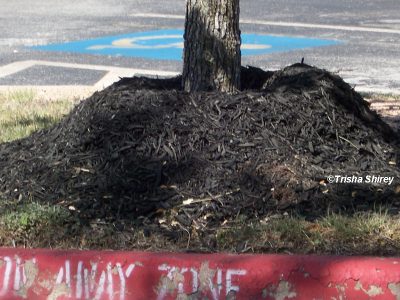How Not to Kill Your Trees

Trees are our most important landscape elements and can add to the value of our homes. Many of the problems that trees have are a result of human error, not nature. Here are some mistakes to avoid that will kill your trees.
- Avoid planting trees too close together or too near the house. Plant most large trees no closer than 10 to 12 feet from the house. If an oak tree is going to be 40 feet in diameter at mature size, it should be 20 feet from your house or another tree. Trees can damage gutters and roofs and provide a means for insects and animals to enter your home. Trees that are crowded will be stressed due to competition for moisture and nutrients. Trees that are too close together may develop leaning or lopsided growth and be weak and unattractive. One tree with a lovely form will be easier to maintain and look better than 3 or 4 packed into that spot. Some very large trees like bur oaks, deodar cedar or pecan are not very suitable for a small residential lot unless you are want total shade! Plant trees that are recommended for your soil type and climate zone also.
- Avoid planting tall trees near or under power lines. They will eventually be pruned and the results are not pretty! We also know the devastating effects when weak limbs fall onto power lines. Just avoid that situation at planting time.
- Remove the burlap or wire on balled and burlapped or B & B trees. Many large trees are sold with their roots wrapped in burlap fabric and bound with wire to hold the root ball together. This wrapping provides for safe transport of the tree, but is not intended to be left on when the tree is planted. It interferes with the growth of the roots as the wire and burlap do not decay quickly. The roots will grow around and around inside that ball until they give up. In a few years, the tree will die.
- Do not plant trees too deeply. Many trees are planted too deeply in their containers, so look for trees with visible root flares in the container. The root flare is the base of the tree trunk that flares out where the trunk meets the soil line. The trunk should not look like a straight stick in the container or in your yard. Soil will often settle a bit after the tree is planted, so don’t dig the hole any deeper that the root ball of the tree and plant the root ball an inch or two higher than the soil grade to compensate for settling.
- Don’t stake the tree and leave the stakes and ties on. Most trees don’t require staking at all. Trees develop stronger trunks when allowed to move with the wind. Stake tall trees, trees on slopes or those that have a leaning growth habit, but remove the stakes within six months. Be sure to cushion wires to avoid damaging the trunk.
categories:
tags:
related:
appeared on episodes:

 Trisha Shirey
Trisha Shirey